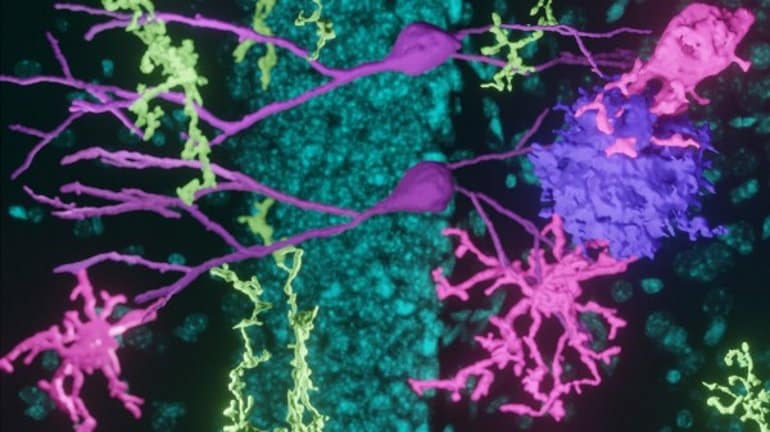Summary: Stimulating the Supramammilary nucleus in the hypothalamus enhanced adult-born neurons in the hippocampus of mouse models of Alzheimer’s disease. These modified adult-born neurons restored both cognitive impairments and mood-related disorders associated with Alzheimer’s in the mice.
Source: UNC
In adult human brains, the hippocampus generates new neurons (adult-born neurons, or ABNs) throughout life, helping us maintain memories and regulate emotions. Scientists call this process “adult hippocampus neurogenesis (AHN)”. In people with Alzheimer’s disease (AD), this process is impaired, leading to reduced production of ABNs with poorer qualities.
Given that AD patients often develop both cognitive symptoms (such as memory loss) and non-cognitive symptoms (such as anxiety and depression) for which AHN plays a critical role, one way to help Alzheimer’s patients achieve symptom relief could be to restore AHN.
Published in the journal Cell Stem Cell, research from UNC School of Medicine scientists demonstrated that stimulating a brain region called Supramammilary nucleus (SuM) located in the hypothalamus effectively enhanced adult-born neurons in the otherwise impaired Alzheimer’s brains of mice.
After patterned stimulation of SuM, AD brains developed more ABNs with improved qualities. Importantly, activation of these SuM-modified ABNs restored both cognitive and affective deficits in AD mouse models.
“It’s been a longstanding question whether AHN can be sufficiently enhanced in impaired AD brains to improve brain function,” said senior author Juan Song, PhD, associate professor of pharmacology and a Jeffrey Houpt Distinguished Investigator at the UNC School of Medicine.
“An important point to consider when addressing these questions is the low-level hippocampal neurogenesis, which becomes even lower in AD patients.
By manipulating a small number of ABNs in the AD brain, we demonstrate that ABNs can be enhanced even in the presence of AD pathology, and these enhanced ABNs are important for the restoration of behaviors and hippocampal function.”
To enhance ABNs in AD brains, Song and colleagues adopted an elegant two-step ABN-enhancing strategy by first stimulating SuM using a patterned optogenetic paradigm with the goal of promoting the generation and developmental properties of ABNs, followed by stimulating the activity of SuM-enhanced ABNs using chemogenetics.
Optogenetics involves the use of light to alter the activity of brain cells expressing light-sensitive opsin genes. Chemogenetics involves the use of inert molecules to alter the activity of brain cells expressing designer’s receptors.
“Interestingly, SuM stimulation alone or activation of ABNs without SuM stimulation failed to restore behavioral deficits in AD mice.” Song said. “These results suggest that multi-level enhancement of ABNs — namely increasing their number, improving their developmental properties, and enhancing their activity — is required to achieve their therapeutic benefits in AD brains.”

When Song and colleagues further analyzed the protein changes in the hippocampus of AD mice in response to activation of SuM-enhanced ABNs, the researchers found that several well-known protein pathways were activated inside cells.
These pathways include the ones important for synaptic plasticity of neuronal cells that allow enhanced communication among them, as well as the ones important for phagocytosis of non-neuronal microglia that allow efficient plaque clearance.
“It is striking that multi-level enhancement of ABNs through combined SuM and ABN stimulations allows such a small number of ABNs make profound functional contribution in diseased AD brains,” Song said.
“We are eager to find out the mechanisms underlying these beneficial effects mediated by activation of SuM-enhanced ABNs on AD pathology and hippocampal function. Future efforts will be needed to develop drugs that mimic these beneficial effects mediated by activation of SuM-enhanced ABNs. Ultimately, the hope is to develop first-in-class, highly targeted therapies to treat AD and related dementia.”
Funding: The National Institutes of Health funded this research through grants R01MH111773, R01MH122692, RF1AG058160, R01NS104530 to Juan Song and R21AG071229, R01GM133107 to co-author Xian Chen, PhD, professor of biochemistry and biophysics at the UNC School of Medicine.
About this Alzheimer’s disease research news
Author: Mark Derewicz
Source: UNC
Contact: Mark Derewicz – UNC
Image: The image is credited to Song Lab, UNC School of Medicine
Original Research: Open access.
“Activation of hypothalamic-enhanced adult-born neurons restores cognitive and affective function in Alzheimer’s disease” by Juan Song et al. Cell Stem Cell
Abstract
Activation of hypothalamic-enhanced adult-born neurons restores cognitive and affective function in Alzheimer’s disease
Highlights
- Patterned optogenetic stimulation of SuM enhances hippocampal neurogenesis in AD
- Activation of SuM-enhanced ABNs rescues memory and emotion deficits in AD
- Activation of SuM-enhanced ABNs promotes hippocampal plasticity and activity in AD
- Activation of SuM-enhanced ABNs increases microglia phagocytosis of plaques in AD
Summary
Patients with Alzheimer’s disease (AD) exhibit progressive memory loss, depression, and anxiety, accompanied by impaired adult hippocampal neurogenesis (AHN). Whether AHN can be enhanced in impaired AD brain to restore cognitive and affective function remains elusive.
Here, we report that patterned optogenetic stimulation of the hypothalamic supramammillary nucleus (SuM) enhances AHN in two distinct AD mouse models, 5×FAD and 3×Tg-AD. Strikingly, the chemogenetic activation of SuM-enhanced adult-born neurons (ABNs) rescues memory and emotion deficits in these AD mice. By contrast, SuM stimulation alone or activation of ABNs without SuM modification fails to restore behavioral deficits.
Furthermore, quantitative phosphoproteomics analyses reveal activation of the canonical pathways related to synaptic plasticity and microglia phagocytosis of plaques following acute chemogenetic activation of SuM-enhanced (vs. control) ABNs.
Our study establishes the activity-dependent contribution of SuM-enhanced ABNs in modulating AD-related deficits and informs signaling mechanisms mediated by the activation of SuM-enhanced ABNs.







